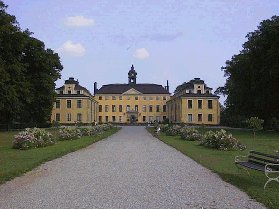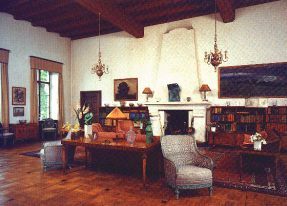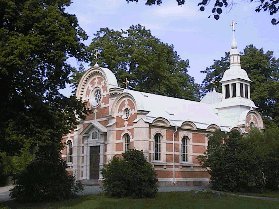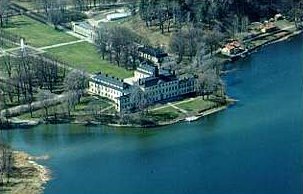
Ulriksdal Palace is situated fairly close to Stockholm by Edsviken, which is a bay of the Baltic Sea. The Palace as such was built in the early 1640s by the Field Marshal Jakob De la Gardie. It was even named after him, as it was originally called Jakobsdal. In those days it looked quite different compared to what you see today. The present exterior dates back to the early 18th century. It has been a Royal Palace since 1715 (nominally), but was first aquired by a Royalty in 1652. The name Ulriksdal came about when the Queen Dowager Hedvig Eleonora gave away the Palace to her grandson as a baptismal gift. The name of the little Prince was of course Ulrik. Unfortunately he died the year after he was born, but at least the Palace's new name was kept. Even though not much is preserved from its oldest days the place has an air of the 17th century anyway. Between 1856 and 1872 King Karl XV used the Palace and re-decorated it to look like 17th century. The bona-fide interiors from that time had been destroyed, primarily in the early 19th century. Some of the king's interiors are still extant and are well worth seeing.
The main part of the Palace is a museum today, while the Swedish section of the Worldwide Fund For Nature resides in the southern wing. The museum can be said to represent two distinctive eras, the one of Karl XV (1826-1872) and the one of Gustaf VI Adolf (1882-1973). In style these two eras couldn't be further away from each other:
Karl was a romantic (in more senses than one!) and dreamed about the days of yore. That's why he created interiors in the "old style". Somewhat dark with lots of antique furniture (and some new, made to look old) and gilt leather hangings. In Sweden the 18th century is particularly revered and most people think that these 19th century interiors are horrible. I don't. I quite like them. Which might mean that I'm a bit of a romantic myself. Besides, interiors like that are definitely an important link in the history of interiors which mustn't be overlooked.
Gustaf VI Adolf started using Ulriksdal as a residence in 1925, following a period of reconstruction and redecoration. In the late 1910s the then interiors of Ulriksdal Palace were hopelessly out of fashion (mind you, the Karl XV interiors were - or became - very fashionable in their time). Gustaf Adolf regarded himself as a modern man and wanted a modern home with a lot of light and air instead of dark panels and stained glass windows. So just about all of that was torn out...

Only one room is preserved from this era in its entirety (i.e. with furniture, objects of art, carpets etc.) and that's the Living-room. Then there are a number of rooms that still have the actual decorations, i.e. panels, roofs and so on, but very little furniture. On the other hand, room is given to Gustaf VI Adolf's collections of graphic art and Scandinavian stoneware.

The Palace Chapel at Ulriksdal was built in the 1860s by Karl
XV. It replaced another chapel which was erected in the late 17th
century. The new one was to be built out of brick and in Dutch
renaissance. Why? Well, partly because the King (and his architect,
Fredrik Wilhelm Scholander) were fond of historical styles, especially
the renaissance, but partly because the new building would be
dedicated to Karl XV's consort, Queen Lovisa, who was a Dutch
Princess. The Chapel was actually called "Queen Lovisa's
Chapel" and inaugurated on her name-day, August 25, 1865.
Today it's simply called "Ulriksdal Palace Chapel".
As with the Palace, Karl XV had the new building decorated with
antique objects from his great collection. The altarpiece, for
instance, is late 16th century and the stained glass windows are
from different times, the oldest one as old as the 15th century!
There are also a couple of rare wall hangings and a pulpit from
the early 17th century.
The Palace Chapel is still frequently used, primarily for baptisms,
confirmation and, not least, weddings. It's an immensely popular
wedding chapel…
The orangery building in the park stood finished in the early 18th century, but it was preceded by another orangery, originally built in the early 1660s, which in turn happens to be the first major building of that type in Sweden. An orangery, for those of you who don't know, is a hothouse of sorts, but mainly used for exotic plants and primarily during winter. What's typical for an orangery is its fairly long and narrow shape and its large windows facing the south. The orangery at Ulriksdal was used for its original purpose (at least to some extent) until 1973, when Gustaf VI Adolf passed away. Then nobody was really interested in Ulriksdal and the orangery (and indeed the Palace) was largely left without care. When plans were made to open up the Palace for the public, there was also an idea to do something with the orangery. From the Nationalmuseum came the idea to turn the building into a museum for Swedish sculpture. The museum was inaugurated in 1988. Here can be seen sculpture from the early 18th century to the early 20th century, including works by Johan Tobias Sergel, Johan Niclas Byström, Bengt Erland Fogelberg and many others.

The Ulriksdal park has undergone enormous changes during its existence. The most famous era was definitely when Magnus Gabriel De la Gardie owned the Palace (1652-1669). At that time the park was known as the most magnificent in Sweden (and one has to remember that Sweden was a lot bigger then than today). One can get a faint idea what it looked like from a copper engraving in Erik Dahlberg's big volume "Suecia Antiqua et Hodierna" (above). There were fountains, sculptures, summer houses and a "Grotto", i.e. a building decorated to look like a cave inside, while on the outside it looked quite ordinary. It had shells and mother-of-pearl on the inner walls... At the far end of the park was a natural rock (which is still there) with a sculpture on top of it, Perseus on his horse, and another sculpture on its side, Andromeda. Andromeda had been taken prisoner by an evil dragon and was chained to the rock. Perseus, of course, had come to rescue her. In a pond by the foot of the rock was the waterspouting dragon. The present park is very much a product of the early 20th century, but it's still possible to see traces of the old arrangements on the grounds. The park is a very popular recreation area, especially during warm summer days.
